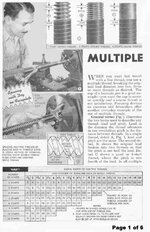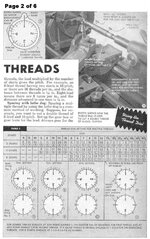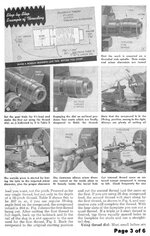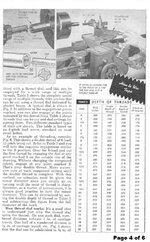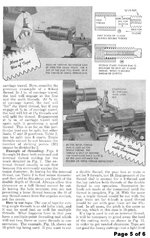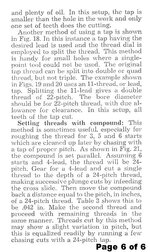AtticusLudwig
Member
Hi everyone, lurker for the last few months, and now I'm finally posting a theory I've been working on since before I got my little metal lathe, or built my wood lathe. Also this is just a text post for tonight, I'm going to try to do some drawings to illustrate some ideas and principles I had, since my turning skills are not so great yet. The process works, but the results aren't pretty yet.
***I have looked around, but haven't seen anyone doing this sort of thing so correct me if I'm wrong. It takes time, and it's failure prone, but it produces real working multi-lead results from a single lead tap.***
So after I first got into fountain pens, I happened upon the Hakase Pen's video, and I was blown away by the lathe, the front facing nature of it, and the way that he can cut threads. I ended up building myself a little front facing wood lathe, and then I decided to tackle the threading.
I heard that with those lathes, the craftsmen can cut triple or even quad start threads when in threading mode. I also looked into buying multi-start threads which I deemed prohibitively expensive for myself for right now, and making your own multi-lead taps which I want to try, but I was certain I could do it the way that the Hakase craftsman does it.
The theory is this: If I have a tool, which has several teeth, spaced with a pitch of 1mm like you see in the video. If I hold the tool still, and the pen/chuck rotates and moves via a leadscrew and engaged half nut. I can cut double-start threads by using a leadscrew with a pitch of 2mm, triple-start threads with a leadscrew of 3mm, and quad-start threads with a 4mm lead screw.
I did the math, with a shaft that has a 2mm, 3mm, and 4mm acme threads cut into it (and corresponding half nuts) You can cut a myriad of threads at several different leads, starts, and pitches. This includes quad-start threads of .5mm, .75mm, and 1mm pitches.
I don't have a shaft that looks like that, and I've only owned my metal lathe for a total of 5 days, so I'm not quite about ready to machine myself one. But I figured out a different way. If I mount my a regular tap (in my case a M10x1.0) into the tool holder, with one of the flutes presented towards the work (the same orientation as If I were going to tap a hole, but offset so that the piece runs into one side of the tap), and set up the thread cutting gears on my mini lathe as if I were going to cut a 3mm thread. I can cut myself a triple-start 1mm thread.
An example of how I set up the lathe:

The reality:
This really works! I was amazed when it actually worked the way I wanted it too. I'm sitting here right now with a "cap" and "section" which are threaded to tripple start M12x1.0. There's a couple of caveats though, I spent a whole day doing this and I broke more than I produced. I am new though, so that could be a lot of it. I also had to turn my pen blanks down from square (ugh.) which took a lot of time. The acrylic blanks I was using wanted to deflect the tap, and then grab it violently, snapping the acrylic where I had turned it down to diameter.
If you feed too fast you risk butting the tap right into the work piece and clogging up the feed and gears, and if you feed too slow the work wants to grab and snap. I found somewhere between 125-150RPM seemed to work best, that was with my little Grizzly 7x14" so setting feed rate was anything but consistent.
I had the most luck doing interior threading, and I realized that the tap seemed to want feed in on the approach and cut when I reversed out. This seemed counter intuitive, but I can confirm that it worked better for me than cutting on the approach and sliding past on the reverse. For interior threading you do have to use a tap that is smaller than the hole you're threading. I used a M10 tap in a 1/2" hole (Roughly 12.2mm dia. I hate mixing imperial and metric, but I didn't have a big enough metric drill bit, or a small enough metric tap.)
When cutting male threads, the piece in the chuck seemed to want to deflect, until it would catch and try to roll over the tap. If you twisted the tap slightly, so that the cutting face presented to the lathe was the "bottom" of a tap flute instead of the "top" the tap would cut when the lathe was reversed, and simply couldn't roll over the tap that way. This also seemed to be a problem with my machine, the tool post that came with the lathe is problematic at best in terms of holding a tap (which It wasn't quite designed to do) . If I could make a custom holder I would. Or simply some sort of square block, drilled and tapped for a set screw, and bored out to the diameter of the tap.
Also I had issues with backlash on my cross slide, and I have no DRO, so if you have those issues figured out, pulling the tap away from the piece, backing out and then re-setting depth might work a lot better.
It's a bit of a crazy setup, but It does allow me to cut multi-lead taps with just my little Grizzly, and a $9 tap I ordered from McMaster. Tomorrow I'm going to try to complete a kitless pen with the stock I have, and hopefully be able to photograph it and show you in the next couple days.
Best,
Atticus
***I have looked around, but haven't seen anyone doing this sort of thing so correct me if I'm wrong. It takes time, and it's failure prone, but it produces real working multi-lead results from a single lead tap.***
So after I first got into fountain pens, I happened upon the Hakase Pen's video, and I was blown away by the lathe, the front facing nature of it, and the way that he can cut threads. I ended up building myself a little front facing wood lathe, and then I decided to tackle the threading.
I heard that with those lathes, the craftsmen can cut triple or even quad start threads when in threading mode. I also looked into buying multi-start threads which I deemed prohibitively expensive for myself for right now, and making your own multi-lead taps which I want to try, but I was certain I could do it the way that the Hakase craftsman does it.
The theory is this: If I have a tool, which has several teeth, spaced with a pitch of 1mm like you see in the video. If I hold the tool still, and the pen/chuck rotates and moves via a leadscrew and engaged half nut. I can cut double-start threads by using a leadscrew with a pitch of 2mm, triple-start threads with a leadscrew of 3mm, and quad-start threads with a 4mm lead screw.
I did the math, with a shaft that has a 2mm, 3mm, and 4mm acme threads cut into it (and corresponding half nuts) You can cut a myriad of threads at several different leads, starts, and pitches. This includes quad-start threads of .5mm, .75mm, and 1mm pitches.
I don't have a shaft that looks like that, and I've only owned my metal lathe for a total of 5 days, so I'm not quite about ready to machine myself one. But I figured out a different way. If I mount my a regular tap (in my case a M10x1.0) into the tool holder, with one of the flutes presented towards the work (the same orientation as If I were going to tap a hole, but offset so that the piece runs into one side of the tap), and set up the thread cutting gears on my mini lathe as if I were going to cut a 3mm thread. I can cut myself a triple-start 1mm thread.
An example of how I set up the lathe:
The reality:
This really works! I was amazed when it actually worked the way I wanted it too. I'm sitting here right now with a "cap" and "section" which are threaded to tripple start M12x1.0. There's a couple of caveats though, I spent a whole day doing this and I broke more than I produced. I am new though, so that could be a lot of it. I also had to turn my pen blanks down from square (ugh.) which took a lot of time. The acrylic blanks I was using wanted to deflect the tap, and then grab it violently, snapping the acrylic where I had turned it down to diameter.
If you feed too fast you risk butting the tap right into the work piece and clogging up the feed and gears, and if you feed too slow the work wants to grab and snap. I found somewhere between 125-150RPM seemed to work best, that was with my little Grizzly 7x14" so setting feed rate was anything but consistent.
I had the most luck doing interior threading, and I realized that the tap seemed to want feed in on the approach and cut when I reversed out. This seemed counter intuitive, but I can confirm that it worked better for me than cutting on the approach and sliding past on the reverse. For interior threading you do have to use a tap that is smaller than the hole you're threading. I used a M10 tap in a 1/2" hole (Roughly 12.2mm dia. I hate mixing imperial and metric, but I didn't have a big enough metric drill bit, or a small enough metric tap.)
When cutting male threads, the piece in the chuck seemed to want to deflect, until it would catch and try to roll over the tap. If you twisted the tap slightly, so that the cutting face presented to the lathe was the "bottom" of a tap flute instead of the "top" the tap would cut when the lathe was reversed, and simply couldn't roll over the tap that way. This also seemed to be a problem with my machine, the tool post that came with the lathe is problematic at best in terms of holding a tap (which It wasn't quite designed to do) . If I could make a custom holder I would. Or simply some sort of square block, drilled and tapped for a set screw, and bored out to the diameter of the tap.
Also I had issues with backlash on my cross slide, and I have no DRO, so if you have those issues figured out, pulling the tap away from the piece, backing out and then re-setting depth might work a lot better.
It's a bit of a crazy setup, but It does allow me to cut multi-lead taps with just my little Grizzly, and a $9 tap I ordered from McMaster. Tomorrow I'm going to try to complete a kitless pen with the stock I have, and hopefully be able to photograph it and show you in the next couple days.
Best,
Atticus

